.jpg)
DS 4 Review
.jpg)
Introduction
If you're wondering but were too afraid to ask, DS Automobiles is Citroen without the Citroen badges.
Of course, when you think of Citroen, the words ‘luxury’ and ‘premium’ don’t spring to mind. So, rather than make futile attempts to convince people otherwise, it separated the DS badge into its own marque, much like SEAT has done with Cupra.
Select's rating score* - 3.9 / 5
At a Glance
The result is a bunch of Citroen cars that don’t look particularly “Citroenny” at all. In fact, DS wants to be known for making prestige vehicles you'll enjoy.
While it’s a bold claim that the French manufacturer is using DS to go after Audi, BMW and Mercedes-Benz, the reality is its cars pack a lot of punch. Moreover, they have so much personality that drivers of the three premium brands’ vehicles will be left wondering why their German four-wheelers look a little dull by comparison.
The new DS 4 is on the tall side for a hatchback and has so much charisma that it’s giving away leftovers in a doggy bag.
The old DS 4 (which still had a Citroen badge on it at the time) was a disappointment. So, we're hopeful of seeing a significant improvement here – and first impressions are good. Although those who remember the old DS 4 will still see its image in the new one, the model is now far less restrained, like a peacock sprawling its feathers.
The looks are very sharp, angular and aerodynamic. It is especially chiselled at the front, with a large grille that looks like a halfway house between Jaguar’s and Audi’s, sitting above a wider lower grille beneath the number plate.
A sizeable body-coloured gap on either side of the grille, created by the very thin headlights, gives the car a frowning appearance. Jagged side lights emanate from the corners of the headlights in an ‘L’ shape down towards the front bumper. Whether you consider it beautiful or ugly, it’s undeniably striking.
The side of the vehicle is eccentric, too, with pronounced lines looking like they're ironed into the car, trying to spell out the angled ‘D’ in the manufacturer’s logo. It's even shaped at the bottom of the doors while the rear window tapers inwards, pointing an arrow towards the car's rear.
Around the back, the DS looks stylish. There’s plenty of space, again in part due to the thin rear lights, which angle towards the middle.
Two styled exhaust pipes sit at the bottom, on either side of diagonal fog lights.
Talk about creating an impression!
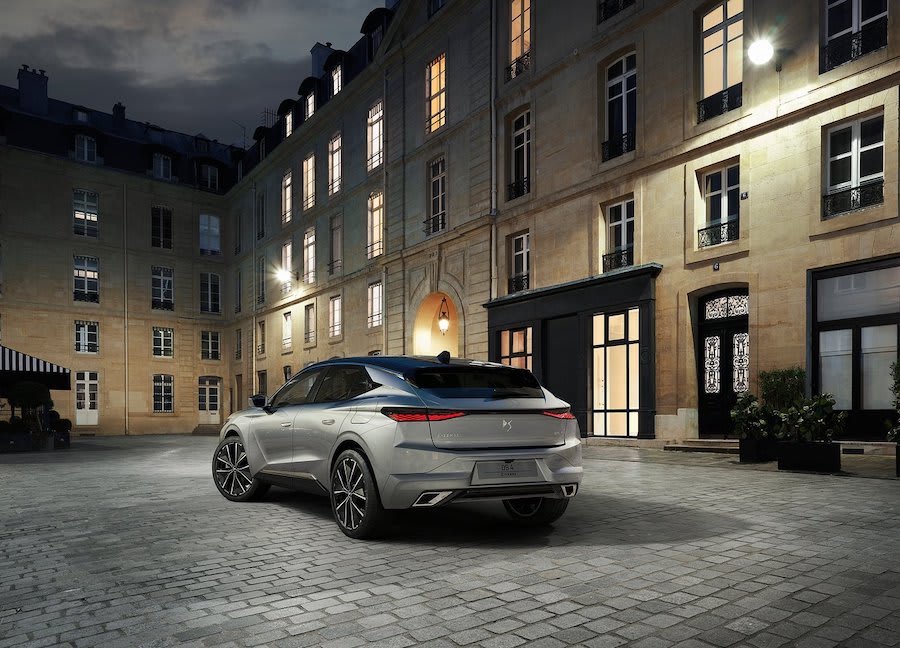
Key Features
There are three versions of the DS 4 – the standard car, the Performance Line and the Cross.
The standard model has more chrome and is built as a regular hatchback. The Performance Line can be considered the sports version, adding in black wheels and more athletic cosmetics. Finally, the Cross takes advantage of the car’s larger proportions to offer a more SUV-focused design as a Crossback, with skid-plates and a roof rack.
On the standard motor, there are four trims available, with wildly varying prices.
Entry-level is Bastille Plus, which comes with 17-inch alloys, rear parking sensors, Apple CarPlay/Android Auto and LED headlights.
Trocadero adds in 19-inch alloys, SatNav, a head-up display, keyless entry and start, an additional touchscreen, parking sensors fore and aft, a reversing camera, and the DS Iris System. This is a voice-controlled assistant that can set up features for you in the infotainment system.
Rivoli (no, not Ravioli) gets laminated glazing on the windows for extra sound-proofing, matrix LED lights, and diamond-cut 19-inch wheels. It also houses DS Drive Assist, which includes adaptive cruise control, lane positioning assist, curve assistance (which will automatically slow the car down around a bend), and rear cross-traffic assist.
Top-of-the-range La Premiere adds 3D LED rear lights.
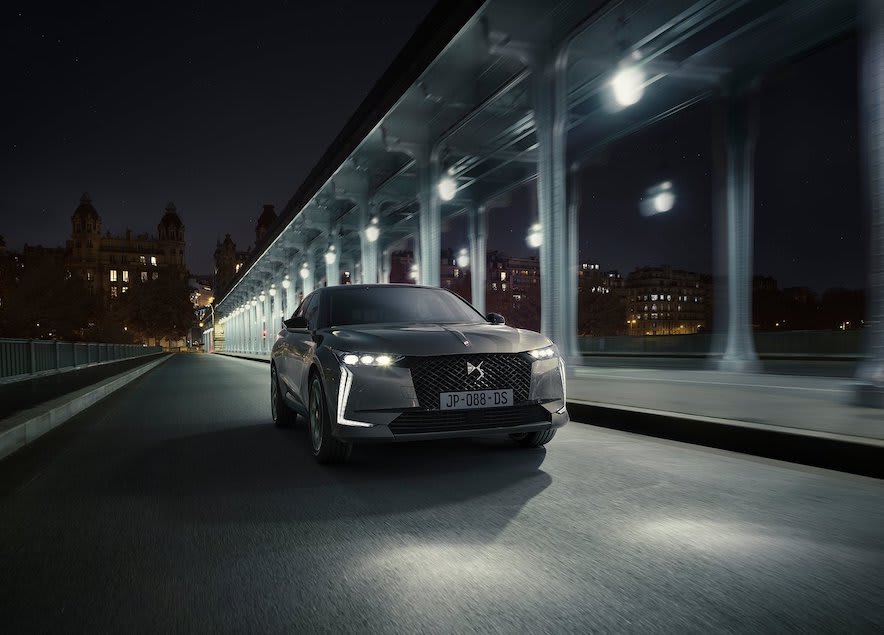
The Performance Line comes in two trims. First, there is the standard Performance Line, which features a seven-inch digital instrument display, a 10-inch touchscreen and 19-inch alloys. Secondly, performance Line Plus adds in the head-up display, the DS Iris System and matrix LED lights.
The Cross version comes in Trocadero and Rivoli trims, whose specifications compare with the standard version of the DS 4.
In terms of engines, there are five powerplants to choose from. All are eight-speed automatics – there is no manual ‘box available.
First up is the PureTech 130 – a 131PS three-cylinder petrol unit. Next, PureTech 180 and PureTech 225 are four-cylinder petrols, producing 181 and 224PS, respectively.
The only diesel in the range is the BlueHDi 130, a four-cylinder turbo lump offering 131PS.
For the environmentally conscious, a plug-in hybrid version is offered, too. It is called the E-Tense 225 - which is a four-cylinder 181PS turbocharged petrol engine connected to an electric motor to produce a combined 224PS. Its 12.4kWh battery can run on electric power alone for journeys up to 38 miles.
Performance & Drive
We are testing the standard DS4 plug-in hybrid version in Rivoli trim. We managed 32 miles in electric-only mode. That is slightly less than the claimed 38 miles, but we weren’t driving with feather-like feet. So, DS’s figures are a reasonably accurate ballpark.
Road noise is more noticeable in all-electric mode, but it’s a quiet, pleasant, and relaxing driving experience. Even when the engine is called into action, it isn’t loud enough to spoil the preceding lack of noise.
Switching to Sports mode will automatically call for the engine. Then, with the accelerator pressed down firmly, it gets from zero to 62mph in 7.7-seconds up to a top speed of 145mph.
The addition of an electric motor adds to the throttle response, providing an instant burst of acceleration.
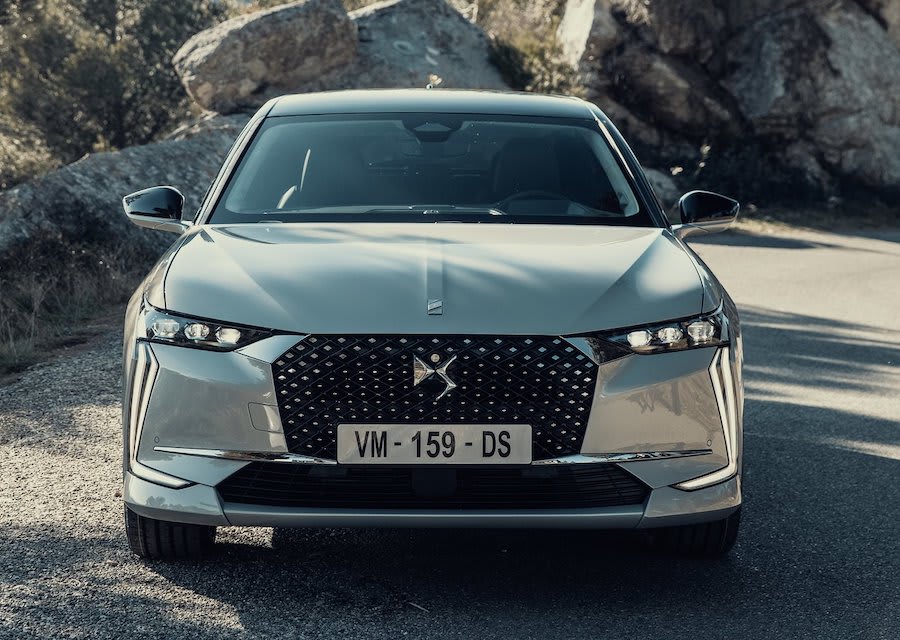
Slowing down feels less secure, thanks to the regenerative braking. This converts the heat from the vehicle’s deceleration to put a bit of charge back into the batteries. It is functional but can make it difficult to judge braking distances. That said, we got used to it, and, in fairness to DS, this is a common trait of cars that rely on electric motors.
The suspension is linked to a camera system called Active Scan that looks out for bumps and prepares the dampers accordingly. It only works in Comfort mode – and only under 60mph – and can sometimes mistake odd reflections or patches of water for potholes. Admittedly, we didn’t notice the impact it had, but the ride is comfortable, and there's a slightly soft springiness to the car without it feeling bouncy. Those opting for larger wheels than our 19-inch alloys will detect a slightly firmer ride.
The DS handles well, albeit without the athleticism that sportier drivers may want. But, this car is more about classiness and sophistication. Still, it remains good to drive.
The steering feels light but not overly responsive, although its precision is perfectly acceptable.
The combination of the above characteristics means the DS 4 is okay around corners - there’s a bit of body roll, and it’s not class-leading. Even so, it doesn’t fight for grip. Of course, you'll struggle to throw it around a bend, but then, as we said, outright performance isn't what this new DS is about. You will need to look towards the German premium brands if you want a better-tuned driving experience.
Our only slight gripe is the gearbox, which doesn’t seem to change gear when you’d expect it to. This is a trait of many cars from Citroen and some sister brands, although a paddle-shift gearbox offered on the hybrid version does get around this. In fairness, you have to concentrate to notice it as the gear changes are smooth, so you probably won't be too bothered.
Overall, the hybrid is the pick of the bunch. The standard petrols aren’t much to write home about. But the diesel is worth looking at if you drive long distances, which outweigh the fuel-saving capabilities of the hybrid once the battery is drained.
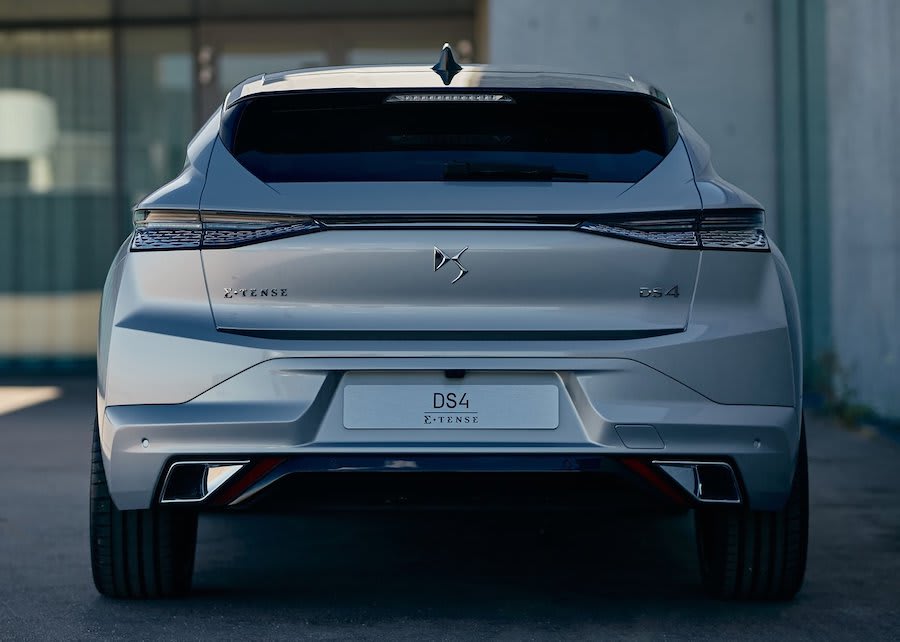
Running Costs & Emissions
Day-to-day costs depend on which engine you choose.
The PureTech 130 manages 47mpg, producing 136g/km of CO2, while the 180 does 43.4mpg (147g/km CO2) and the 225 achieves 42.8mpg (149g/km CO2).
The BlueHDi 130 four-cylinder turbodiesel will do 58.8mpg (126g/km CO2), while the hybrid claims up to 217.2mpg. However, as with all hybrids, that figure depends on you having the battery topped up, and much lower figures are more likely in practice.
It also releases just 30g/km of CO2. And, when it comes to Benefit In Kind tax (Bik), that keeps it in the same band as an Audi A3 plug-in hybrid, lower than the BMW 1 Series.
There is also up to 38 miles of all-electric, petrol-free, emission-free driving. Or you can use the battery power over longer journeys to raise the miles-per-gallon figures as much as possible.
The DS 4 is too new to have been part of any reliability surveys – in fact, the DS brand as a whole is – but Citroen has improved vastly over the years.
In case you’re interested, a standard three-year warranty comes with the DS, although the battery in the hybrid is covered by its own eight-year guarantee of up to 100,000 miles. That should give you an indication of DS’s belief in its cars.

Interior & Technology
The interior of the DS 4 is as striking as the exterior.
It impresses at first glance, with decent-sized screens and a well-shaped dashboard. The flat-bottomed steering wheel looks imposing, if a tad boxy with its square-ish airbag cover.
The screens are crisp and clear – a significant improvement on previous DS models. A second touchscreen on the centre console can be customised so you can set your own shortcuts. At the same time, the editable heads-up display is excellent, with plenty of information, without distracting you from your view of the road.
DS has tried to base the design of its screens on a smartphone, and it has done an excellent job. They’re responsive and sensitive to the touch, so you don’t need to keep jabbing your fingers at them to get them to do something.
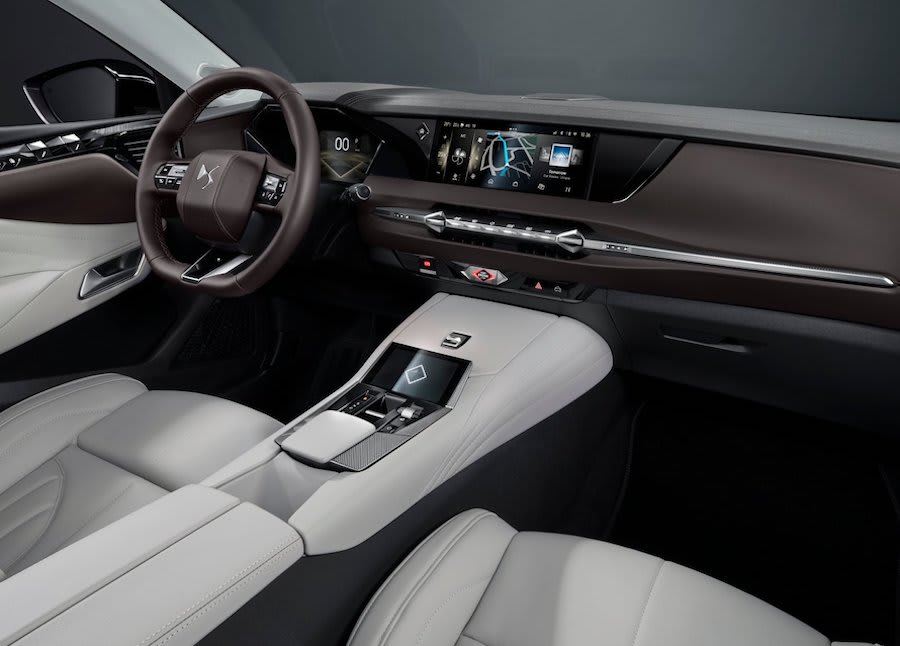
Most air vents are well-hidden, thanks to the clever layout. And, because of the plethora of digitised features, there’s a vibe of minimalism in the cabin, yet it doesn’t look bare. There is, at least, a physical volume knob for the radio, while air conditioning and electric window switches remain.
There are plenty of plush, soft-touch materials that add to the premium feel. Hardened, cheaper plastics are out of sight, and the cabin has more character than the DS 4’s rivals.
There is quite a lot to set up when you first get in. But the configurability is superb, and it means every driver can customise the car’s systems to get to exactly what they want quickly. In addition, the shortcut buttons that you can set will become intuitive to use once you get used to where everything is.
The visibility out of the front is fine, but the large pillars on either side of the rear windows can restrict your view out of the back.
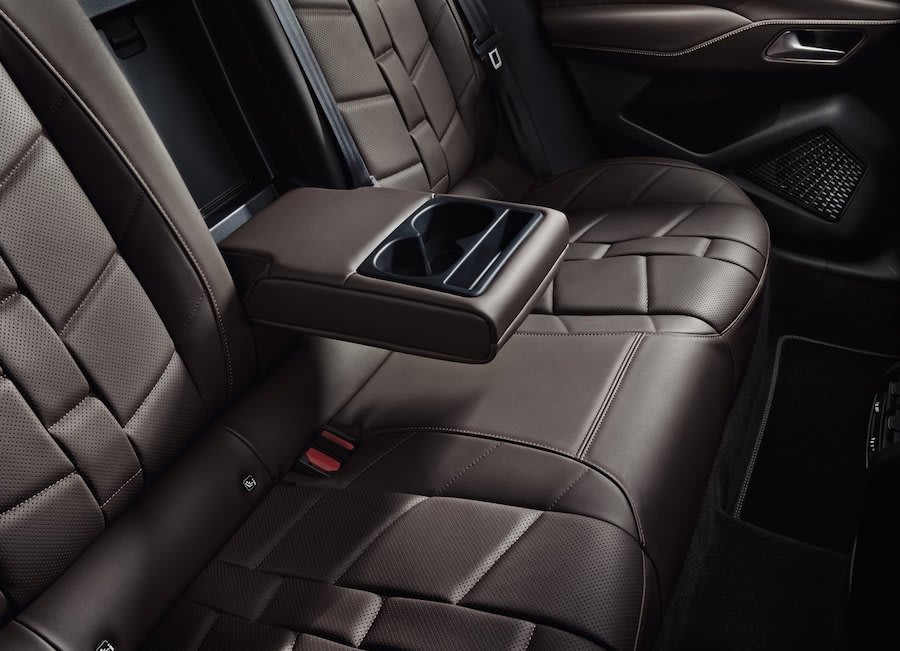
Practicality & Boot Space
There is plenty of room in the front, and the seats are comfortable. But, annoyingly, there’s no adjustable lumbar support offered on the DS 4. The spaciousness of the front appears to limit the room in the back, though. The front seats are pretty big, limiting the amount of available space to put your feet if you're sitting behind. And, if that’s restricted, the legroom is compromised, too.
Thanks to the vehicle’s larger proportions, there’s a decent amount of headroom to make up for it. But it means taller passengers will feel they’re sitting more bolt upright than settled down into the seats, which might make longer journeys more tiring. In addition, the optional sunroof, if chosen, will reduce the headroom available.
In the boot, you’ll find 430-litres of usable space (390-litres in our hybrid due to the batteries beneath the floor). This expands to 1,230-litres, with the rear seats folded down in a 60/40 configuration.
In the cabin, there are a couple of cupholders in the front, a USB port and some valuable space in the front armrest. The door-bins are of average size.

Safety
The latest DS 4 is yet to be tested by Euro NCAP.
The 2019 DS 3 Crossback was assessed in 2019 and earned a four-star safety rating, scoring 87 per cent for adult occupants, 86 per cent for children and 63 per cent for safety assists.
The crash-safety body also tested the same vehicle with optional safety systems fitted, which bumped up the rating to five stars, 96 per cent, 86 per cent and 76 per cent, respectively.
That should give you some idea of the ballpark the new DS 4 is in. However, it's worth noting that Euro NCAP made its tests more stringent in 2020. Therefore, a rating awarded before then isn’t necessarily comparable with today.
You get automatic emergency braking, lane-keep assist, hill-start assist, and driver attention alert as stock kit across the DS 4 range for peace of mind.
You will have to spend a bit more to get the Advanced Safety Pack. This includes adaptive cruise control rear traffic detection, advanced emergency braking and extended traffic sign recognition.

Options
Other than the safety pack, there aren’t that many options on the DS table.
You can choose from a cloth or leather interior trim, while Alcantara is extra.
The exterior colour is copper-gold as standard, while black, grey, dark grey, crystal (basically a light grey) and red will cost a little more. White is more expensive still.
Rival Cars
The Audi A3, BMW 1 Series and the Mercedes A-Class are obvious alternatives. And, while they are better cars, there's something about the DS 4 that screams personality over the default go-to German euro boxes.
Surprisingly, the A3 and the A-Class are both cheaper. That is not something we were anticipating, so it’s worth bearing in mind.
In truth, the DS 4 is still a step down from the premium Bavarian brands. But it does make a Ford Focus, Volkswagen Golf, Mazda 3, and Seat Ibiza look distinctly second-class.
Given the DS 4’s taller stature, you also might want to consider a BMW X2, as well as a Cupra Formentor or a Lexus UX, if an SUV is more appealing.
If you are not bothered by having a premium brand, then a Renault Arkana and Kia XCeed are also worth looking into.
Verdict & Next Steps
Overall, the DS 4 is a likeable, worthy contender that performs admirably.
BMW, Audi and Mercedes-Benz won’t be rushing to take one apart for its ground-breaking engineering, but they might be troubled by its sheer charisma.
It is classy, drives reasonably well and has a feel of quality, both inside and outside. The model is packed with technology, too - which will excite you if you’re fashion-conscious and after the latest gadgetry.
The DS 4’s pulling power is more in its vibrant looks than its outright performance. But, as we keep saying, it has personality in spades, which makes German rivals look a bit bland – and that's what DS intended.
Just as the Renault Megane was once “shaking that ass” in its famous TV commercial all those years ago, the DS 4 has cheekiness in abundance that’s endearing as well as enormously persuasive.
Where to next?
View latest DS 4 leasing deals - from just £341.43 per month inc VAT**
Looking for a great deal? Check out our incredible range of car lease deals
New Large Hatchback? Read our latest Car Reviews and find the right model for you
Want to know more about leasing? Take a look at our comprehensive Leasing Guides
Interested in everything motoring? Why not catch up on all the latest Car Leasing News.
**Score based on Select’s unique meta score analysis, taking into account the UK’s top five leading independent car website reviews of the DS 4
**Correct as of 15/11/2021. Based on 9 months initial payment, 5,000 miles over a 48 month lease. Initial payment equivalent to 9 monthly payments or £3072.87 Ts and Cs apply. Credit is subject to status.




















